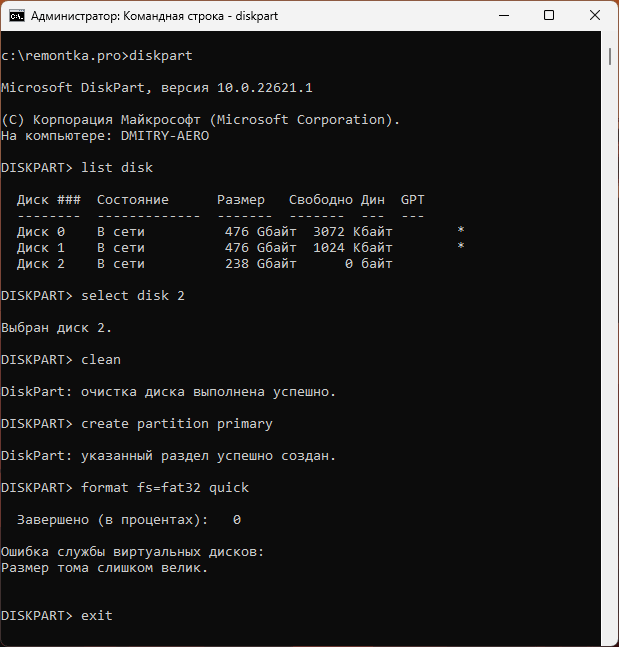Недавно на сайте была опубликована статья о том, какую файловую систему выбрать для флешки внешнего жесткого диска — FAT32 или NTFS. Теперь же — инструкция о том, как отформатировать флешку в FAT32. Задача не сложная, но в некоторых случаях возможны проблемы: отсутствие выбора нужной файловой системы или сообщения о том, что том слишком велик для конечной файловой системы.
В данной инструкции по порядку рассмотрим, как это сделать в Windows 11 и 10 (и предыдущих версиях), Mac OS X и Ubuntu Linux. Также может оказаться полезным: Что делать, если Windows не удается завершить форматирование флешки или карты памяти.
Форматирование флешки в FAT32 в свойствах диска
Первый вариант — самый быстрый и простой, но сработает не для любых накопителей. Необходимые шаги:
-
- Подключите флешку к компьютеру и откройте «Мой компьютер». Кстати, вы можете сделать это быстрее, если нажмете клавиши Win + E (латинская E).
- Кликните правой кнопкой мыши по нужному USB накопителю и выберите пункт контекстного меню «Форматировать».
- Подключите флешку к компьютеру и откройте «Мой компьютер». Кстати, вы можете сделать это быстрее, если нажмете клавиши Win + E (латинская E).
- Выберите нужную файловую систему в списке и, при необходимости, укажите остальные параметры (можно оставить по умолчанию). Всё, что останется сделать — нажать кнопку «Начать», ответить «ОК» на предупреждение о том, что все данные на диске будут уничтожены.
В результате накопитель будет отформатирован и вы увидите сообщение о том, что форматирование завершено.
В командной строке
Если файловая система FAT32 не отображается в диалоговом окне форматирования, можно использовать командную строку для форматирования с помощью команды FORMAT или утилиты DISKPART.
В первом случае достаточно запустить командную строку (лучше — от имени администратора) и ввести команду (заменив букву диска E на нужную):
format /FS:FAT32 E: /q
После этого можно ввести метку диска (или просто нажать Enter), и подтвердить форматирование накопителя нажатием клавиши Y с последующим вводом:
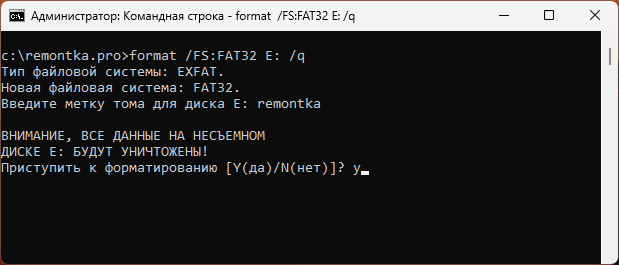
Вторая возможность — использование команд DISKPART:
- Запустите командную строку от имени администратора.
- По порядку выполните команды (заменив N на номер диска в 3-й команде):
diskpart list disk select disk N clean create partition primary format fs=fat32 quick exit
Если всё прошло успешно, флешка будет отформатирована, иначе придётся прибегнуть к следующему способу.
Утилита FAT32 Format (форматирование флешки большого размера)
При попытке форматирования USB-накопителя большого размера в FAT32 в Windows вы можете столкнуться с проблемами:
- Отсутствие возможности выбрать файловую систему FAT32 в диалоговом окне форматирования
- Сообщение о том, что том слишком велик для FAT32 в командной строке или DISKPART
При этом в действительности размер раздела FAT32 может быть равным 2 Тб, ограничения накладывает лишь Windows. Их можно обойти с помощью сторонних программ для форматирования, в частности — FAT32 Format:
- Скачайте GUI-версию приложения FAT32 Format с официального сайта (загрузка производится при нажатии на скриншот окна программы) и запустите её.
- Выберите вашу флешку в списке доступных (чтобы она отображалась в списке, ей должна быть назначена буква) и нажмите кнопку Start (параметры можно оставить заданными по умолчанию).
- Подтвердите форматирование накопителя и то, что вы осознаете, что данные с него будут удалены.
- Дождитесь завершения форматирования.
Готово, флешка, независимо от её размера (если он не превышает 2 Тб) будет успешно отформатирована в файловую систему FAT32.
Как отформатировать флешку в FAT32 в MacOS
Если вы владелец компьютера или ноутбука с MacOS, для форматирования можно использовать дисковую утилиту:
- Откройте дисковую утилиту (Запустите Finder — Приложения — Дисковая утилита)
- Выберите флешку, которую следует отформатировать и нажмите кнопку «Стереть»
- В списке файловых систем выберите FAT32 и нажмите стереть, дождитесь, когда процедура будет завершена. Не отключайте USB накопитель во время форматирования.
В Ubuntu Linux
Для форматирования флешки в FAT32 в Ubuntu, найдите в поиске приложений «Диски» или «Disk Utility», если вы используете английский язык интерфейса. Откроется окно программы. В левой части выберете подключенную флешку, после чего с помощью кнопки с иконкой «настроек», вы можете отформатировать флешку в нужный вам формат, в том числе, в FAT32.

Кажется, рассказал обо всех наиболее вероятных вариантах при процедуре форматирования. Учитывайте, что в современных реалиях более осмысленным может быть форматирование в ExFAT — как наиболее совместимый вариант файловой системы без ограничений, присущих FAT32.
Use File Explorer (drives smaller than 32GB) or Powershell (for drives greater than 32GB)
Updated on March 11, 2023
What to Know
- File Explorer: Go to File Explorer > This PC > right-click the USB Drive > Format > Start > OK.
- Or launch Powershell > enter format /fs:fat32 : and wait for the process to finish.
- You can format drives smaller than 32GB in File Explorer; for larger drives, you must use Powershell.
This article explains how to format a USB drive in FAT32 on Windows. Instructions apply to both Windows 11 and 10.
How to Format a USB Drive as FAT32 Using File Explorer
Using File Explorer to format USB to FAT32 is the easiest method.
It’s only possible to format a drive smaller than 32GB in FAT32 format using this method. Any data previously contained on the USB drive is removed during the formatting process.
-
Select File Explorer (the folder icon) in the Windows 11 taskbar.
-
Select This PC on the left side of File Explorer.
-
Right-click the USB Drive and select Format.
-
If the File system isn’t listed as FAT32, click on the drop-down menu and choose it.
-
Select Start.
-
Wait for the drive to format then select OK to finish the process.
Format a USB Drive in FAT32 Using Powershell Command Line Tools
If you want to format a drive larger than 32GB, then your only option is to use Windows 10’s Powershell Command Line Tools to do so. It’s a much slower process than through File Explorer, but it works. Here’s how to format a USB drive using the command line function.
As before, any data previously stored on the USB drive is removed during the formatting process.
-
Select the Search Bar.
If you don’t see the search bar, select Start (the Windows icon) in the taskbar.
-
Type in Powershell.
-
Select Powershell.
-
Type format /fs:fat32 :
-
Wait for the process to complete.
Formatting this way can take a long time.
Pros and Cons of Using FAT32
FAT32 is an old file system that’s been around for many years. That means it’s not an ideal fit for Windows 10. However, there are reasons why you might want to use it. We delve into a brief overview of the pros and cons behind FAT32.
- FAT32 is near-universal. If you frequently move your USB drive between PC, Mac, Linux system, and even your phone, FAT32 is a good choice. That’s because it has near-universal compatibility, so you can easily share files using this file system.
- FAT32 can’t be used on drives larger than 16TB or files larger than 4GB. FAT32 isn’t able to work with hard drives larger than 16TB. That won’t affect many users yet, but it cannot deal with files over 4GB in size. That can be a big issue nowadays, especially if you regularly edit videos.
- FAT32 is slightly slower. FAT32 is somewhat slower than its alternatives—NTFS and exFAT. It might not make a huge difference at first, but it all adds up, and if you don’t require universal support, you may as well use NTFS or Microsoft’s exFAT file system instead.
FAQ
-
To format an SD card to FAT32, select This PC in File Manager and right-click your SD card in the Devices section. Select Format and choose FAT32 from the File System drop-down menu. Select Start > OK.
-
FAT32 is the latest version of the File Allocation Table (FAT) file system. It supports drive sizes up to 2TB and can go as high as 16TB with 64KB clusters. A FAT32 volume can hold up to 268,173,300 files using 32KB clusters.
-
To format a USB flash drive to FAT32 on a Mac, connect the drive to your Mac, open Disk Utility, and select the flash drive. Rename the USB drive and select MS-DOS(FAT) as your format option. Select Erase.
Thanks for letting us know!
Get the Latest Tech News Delivered Every Day
Subscribe
Большинство смартфонов и планшетов позволяют подключать к ним флешки и даже внешние SSD диски объемом более 64 Гбайт, сделав ее дополнительным хранилищем информации для гаджета. Но эти носители должны использовать файловую систему FAT32, и вам нужно знать, как отформатировать 64 Гб в FAT32. В Windows 10 такая возможность по умолчанию не предусмотрена. Но мы сейчас расскажем, как это сделать без особых проблем.
Содержание
- Как отформатировать диск в FAT32
- Как форматировать через FAT32 в MacOS
- Как отформатировать флешку в FAT32 с помощью командной строки
Как отформатировать диск в FAT32
Как мы и сказали, операционная система Windows 10 не позволяет сделать это стандартными средствами (на скриншоте видно, что диск или флешку можно отформатировать лишь в NTFS). Но эту проблему легко решают всевозможные бесплатные утилиты. Например, достаточно популярная FAT32 Format, интерфейс которой отличается максимальной простотой.
- Скачайте приложение FAT32 Format с официального сайта разработчика. Для этого достаточно просто кликнуть по скриншоту окна программы.
- Подключите флешку или внешний накопитель к USB-разъему компьютера.
- Запустите приложение FAT32 Format и выберите нужную флешку в списке доступных, после чего нажмите кнопку «Start». Никакие дополнительные настройки, доступные в приложении, для этого менять не обязательно. По умолчанию будет выбрана и файловая система FAT32.
- Подтвердите форматирование флешки или диска и дождитесь завершения процедуры.

ridgecrop.co.uk
Внимание! Операция форматирования в FAT32 удалит все записанные на флешке или внешнем диске файлы. Убедитесь, что на ней отсутствуют нужные вам данные, а если они есть — скопируйте их на внутренний диск компьютера или другой носитель.
Как форматировать через FAT32 в MacOS
Владельцам компьютеров и ноутбуков Apple, работающих под управлением MacOS, немного проще. Возможность форматирования накопителя в FAT32 предусмотрена в самой операционной системе. Если же вы ищете внешний SSD, то вам наверняка пригодится наша подборка подобных устройств.
- Откройте Finder -> Приложения -> Дисковая утилита.
- Выберите нужный накопитель в списке доступных и нажмите «Стереть».
- Укажите файловую систему FAT32 и еще раз нажмите «Стереть», после чего дождитесь завершения процедуры и извлеките флешку.
Как отформатировать флешку в FAT32 с помощью командной строки
Да, графический инструмент, дающий возможность отформатировать флешку в FAT32 в Windows отсутствует, но у командной строки такого ограничения нет. И если вы думаете, как лучше форматировать флешку FAT32 или внешний накопитель без использования дополнительных программ, этот способ подойдет как нельзя лучше.
- Подключите накопитель к USB-разъему компьютера.
- Проверьте, какая буква присвоена подключенному накопителю. Для этого откройте «Проводник» и найдите название диска или флешки в левой части окна. Буква в скобках — это именно то, что нам нужно запомнить.
- Кликните левой кнопкой мыши по меню «Пуск» и начните вводить надпись «Командная строка».
- Нажмите на название «Командная строка» в результатах поиска правой кнопкой мыши и выберите «Запуск от имени Администратора».
- Введите команду format x: /fs:fat32 /q, где «x» — это буква диска или флешки, которую нужно отформатировать в FAT32. Кстати, управление выбором файловой системы здесь также предусмотрено. Для этого просто укажите нужную файловую систему после «fs:».
- Нажмите Enter и дождитесь завершения процедуры. В некоторых случаях до начала форматирования вам будет предложено ввести букву диска, под которой он будет отображаться в системе. Такое переименование может быть полезно.
Читайте также
- Буфер обмена на iPhone — как пользоваться
- Топ-4 способа отредактировать фото на iPhone без стороннего ПО
Do you want to format a drive to FAT32? In some cases, the Windows may not offer FAT32 format option and you can’t format to FAT32. Why does the «FAT32 not an option» issue occur and how to solve this issue? In this post, MiniTool will give you answers.
FAT32 Not an Option Windows 10
I just finished adding OTG support to my PSC with a 4 GB 2.0 USB drive and now I’m getting ready to format my new 128 GB 3.1 USB drive and add AutoBleem/games to the drive. When I try to format the new drive, it doesn’t have a FAT32 option. My only options are exFAT (default) and NTFS. —reddit.com
Released in 1977 by Microsoft, FAT32 is the most common version of the FAT file system and has great compatibility. It is widely supported by many portable and embedded devices. Some people may have old devices (such as PSP, XBOX360, some TVs and some XP machines without exFAT patch) that only support FAT32 file system.
NTFS vs. FAT32 vs. exFAT – Differences and How to Format to
Nowadays, they want to extend the storage but they find that the system can’t format the drive to FAT32. If they format the drive in Windows, the system will not display the FAT32 option. Actually, the reason why you can’t format to FAT32 is that the FAT32 file system has size limit (32 GB), which is set by Microsoft manually.
On a hard drive with 512-byte sectors, the real size limit of FAT32 is 2TB. On a hard drive with 2 KB sectors and 32 KB clusters, the real size limit is 8 TB. On a hard drive with 4 KB sectors and 64 KB clusters, the real size limit is 16 TB.
Nowadays, most hard drives are 512-byte sector or 4 KB sector drives. Therefore, the real size limit of FAT32 should be 2TB or 16TB. But to utilize storage space, Microsoft manually limits the max FAT32 size to 32 GB.
Further Reading:
When you create a 32 GB FAT32 partition (32768 MB) on a 512-byte sector drive (I use Windows 10 system), the default cluster size is 32 KB, which is much larger than 4 KB, the default cluster size of NTFS file system.
A partition is composed of many clusters. The cluster is the unit for the PC to read and write the file. The process of writing data will consume clusters. In general, a file can occupy multiple clusters, but a cluster can’t be occupied by more than one file.
For example, if the cluster size is 32 KB, a file will be written into drive in the unit of 32 KB. If the file is 100 KB, it will use up 4 clusters. In the last cluster, only 4 KB space is used and 28 KB space is wasted, because this cluster can’t be occupied by another file although it has free space still.
However, if the cluster size is 16 KB, the PC will use 7 clusters to store 100 KB data. And in the last cluster, only 12 KB (16 – 4) space is wasted.
Obviously, the smaller the cluster, the more fully the disk space is utilized. If you want to know more about cluster size, you can read this post: What Allocation Unit Size Should I Use For FAT32?
How to Fix the FAT32 Not an Option Issue
Sometimes, you have to format a drive larger than 32 GB to FAT32. However, if you format the drive in File Explorer or Windows Disk Management, the “FAT32 not an option” issue will occur. If you format the drive with Command Prompt, it will tell you it can’t format to FAT32 because the volume size is too big.
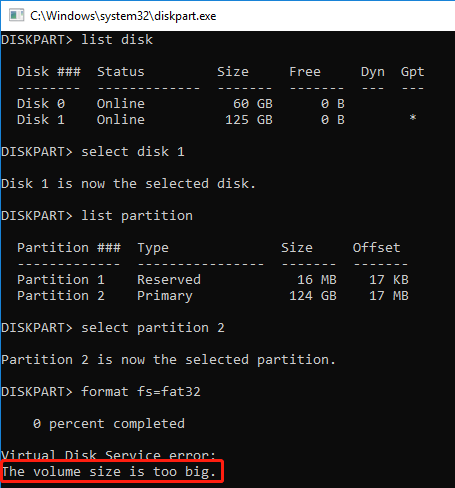
Then, what to do if it can’t format to FAT32? You can use the following 2 ways to work around this issue.
Tip: Sometimes, the reason why you can’t format to FAT32 is not the “FAT32 not an option” issue. One of possible reason is that it is a write-protected drive. To solve this issue, please refer to this post: The Disk Is Write-protected? Remove It from USB Windows 10/8/7!
Fix 1. Format the Drive to FAT32 with MiniTool Partition Wizard
MiniTool Partition Wizard is a professional disk management tool. It allows you to format a drive larger than 32 GB to FAT32 for free. If you can’t format USB to FAT32 or can’t format SD card to FAT32, you can try it. Here is the guide:
MiniTool Partition Wizard DemoClick to Download100%Clean & Safe
Step 1: Launch MiniTool Partition Wizard and go to its main interface. Right-click the partition you want to format to FAT32 and choose Format from the menu.
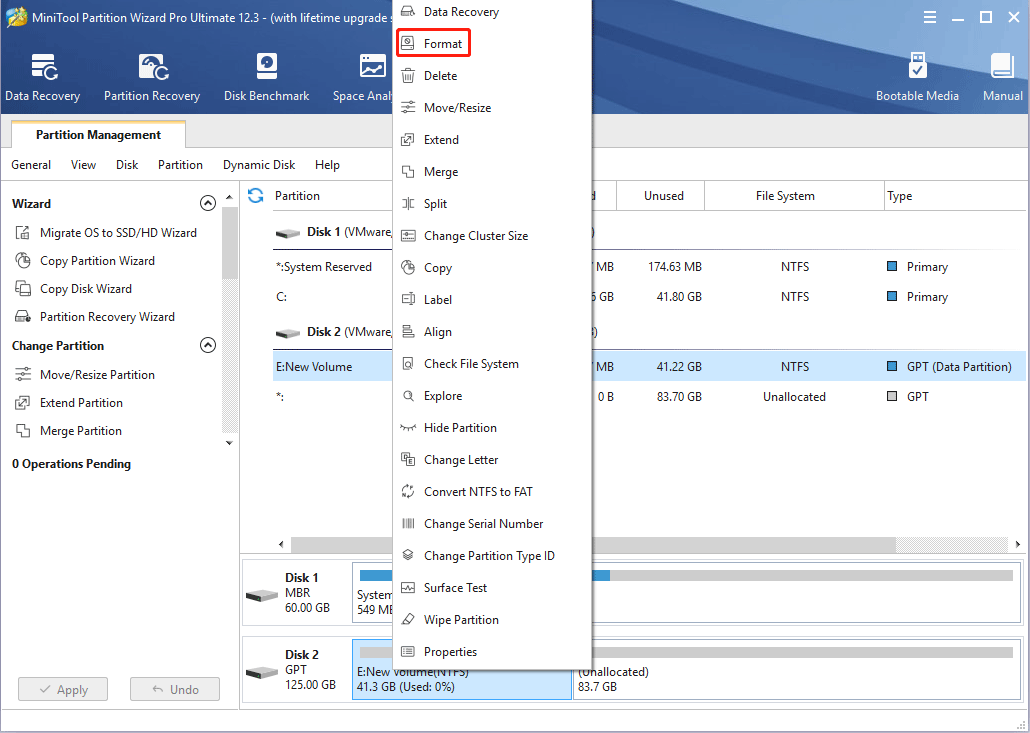
Step 2: In the Format Partition window, expand the drop-down menu next to File System and choose FAT32. Then, click OK button.
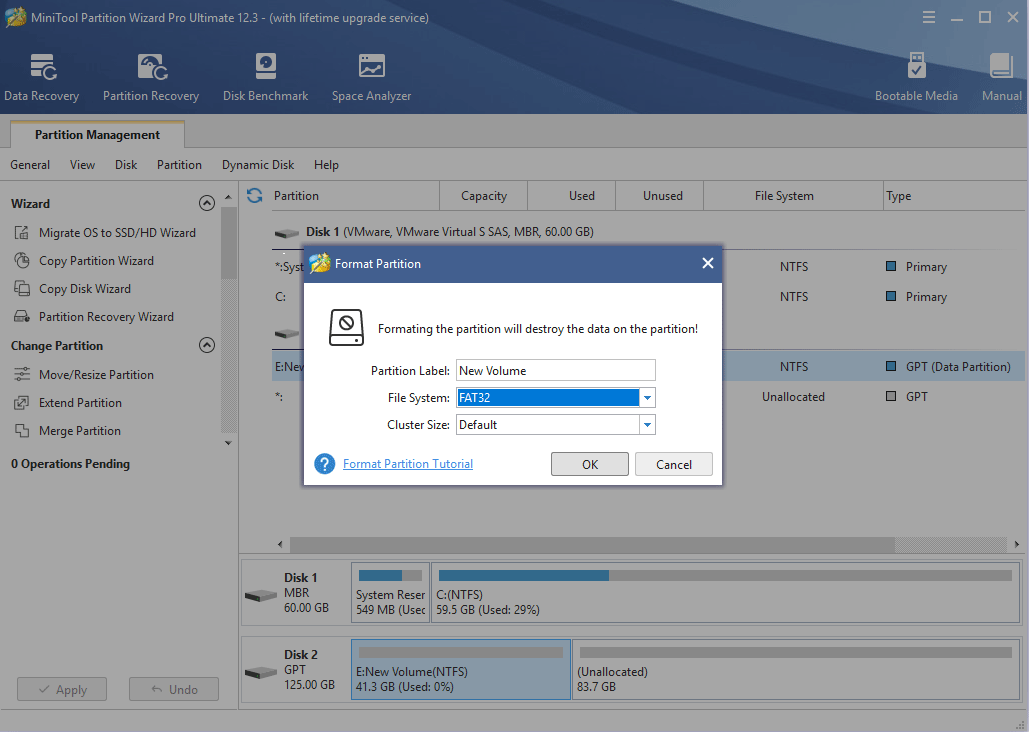
Step 3: Click the Apply button to execute the pending operations.
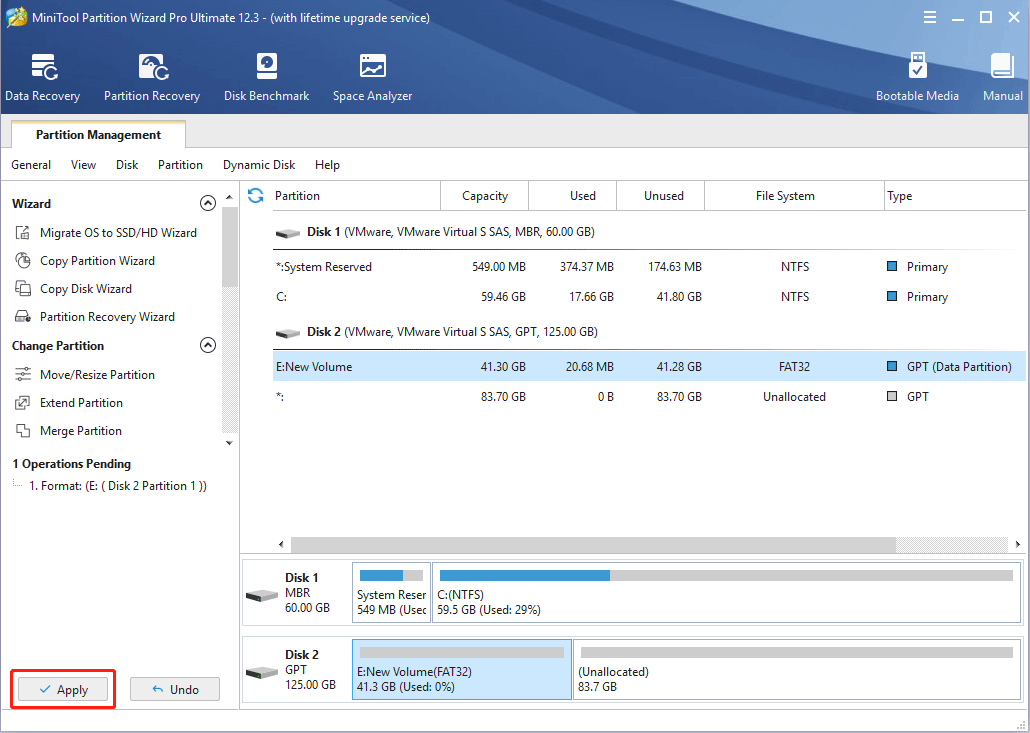
Tip: If the file system of the drive is NTFS and there are important files in the partition, you can use the Covert NTFS to FAT feature to format the drive to FAT32 without data loss. But please note that this feature is not free.
The Best FAT32 Formatter to Format SD Card/USB Drive
Fix 2. Extend the FAT32 Partition with MiniTool Partition Wizard
If you have created a 32 GB FAT32 partition on the drive and there is a lot of free space the drive still, you can extend the partition with MiniTool Partition Wizard. Here is the guide:
MiniTool Partition Wizard DemoClick to Download100%Clean & Safe
Step 1: Launch this software and go to its main interface again. Right-click the FAT32 partition and choose Extend from the menu.
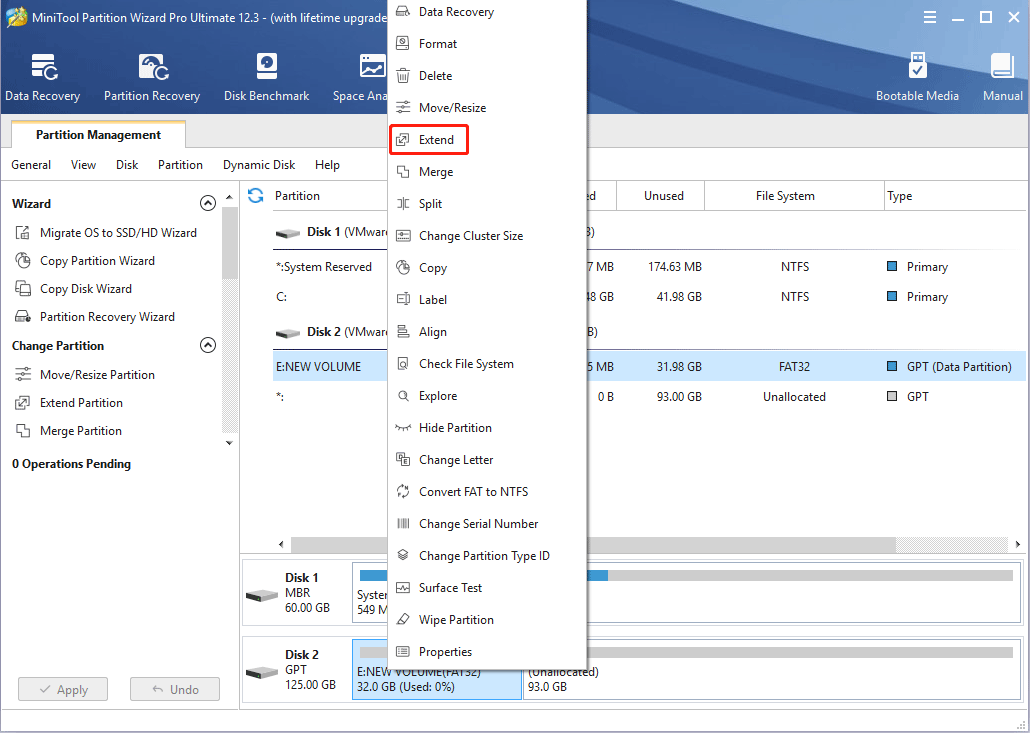
Step 2: In the Extend Partition window, choose where to take free space (another partition or unallocated space). Drag the blue block to determine how much space you want to take. Then click the OK button.
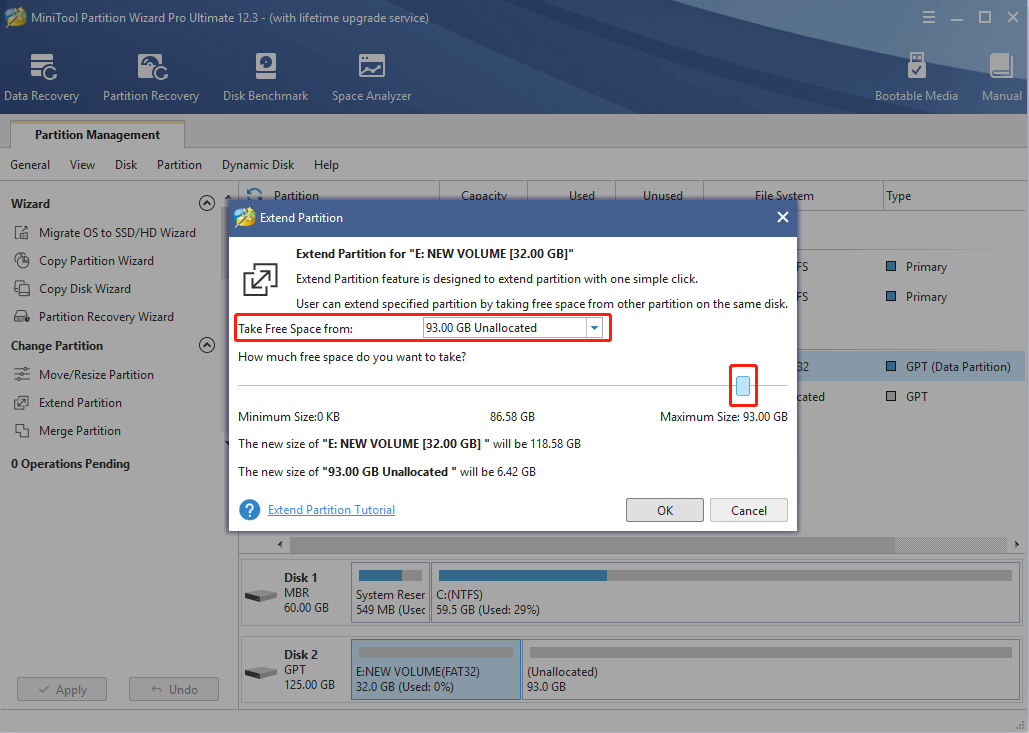
Step 3: Click the Apply button to execute pending operations.
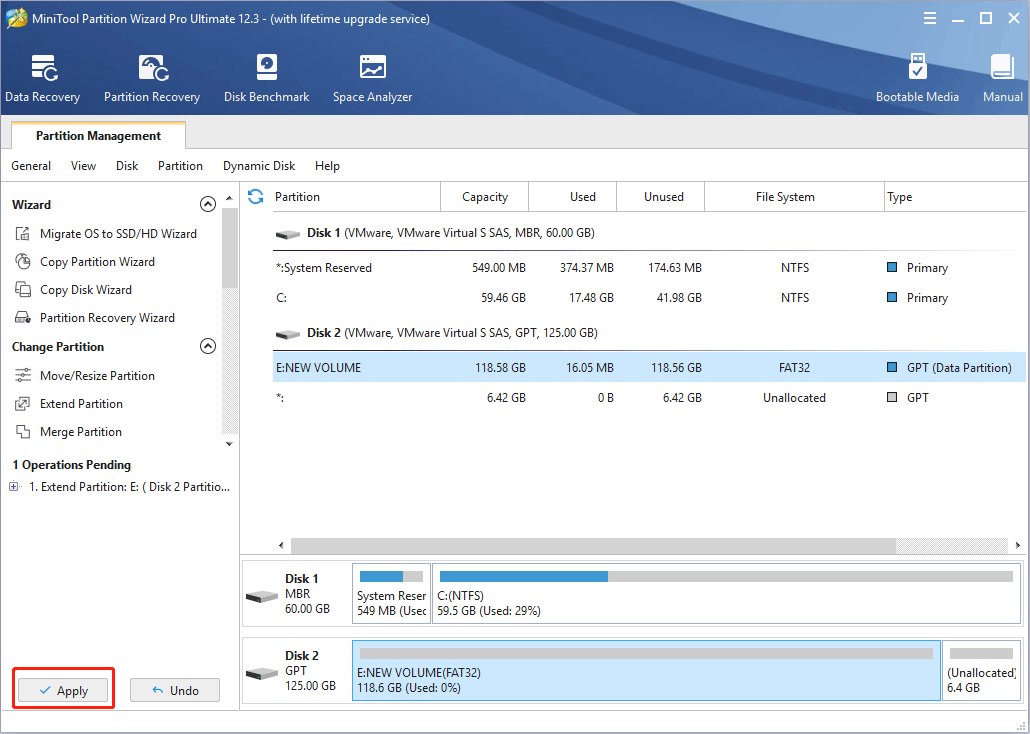
Two Ways to Extend Partition Windows 10 Without Losing Data
Further Reading:
When you format the drive to FAT32 or extend the FAT32 partition, the cluster size will vary depending on the partition size. As mentioned above, the cluster size is related to space utilization. To utilize space more fully, you can change the cluster size to a smaller value.
MiniTool Partition Wizard can help you check the cluster size of a partition and change it. Here is the guide:
MiniTool Partition Wizard DemoClick to Download100%Clean & Safe
Step 1: Launch MiniTool Partition Wizard and go to its main interface. Right-click the FAT32 partition and choose Properties.

Step 2: Skip to File System Info tab. The Sectors per Cluster will tell you the cluster size of the partition (in the picture, the cluster size is 16384 bytes / 1024= 16 KB). Then, you can decide whether to change the cluster size.
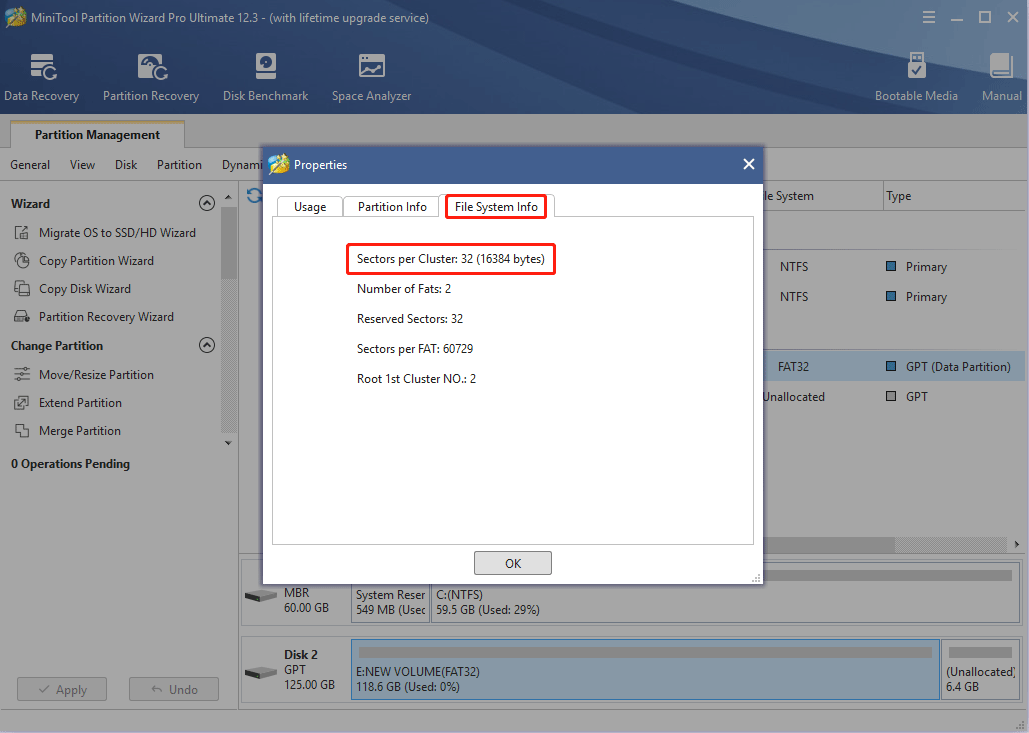
Step 3: If you decide to change the cluster size, please right-click this partition again and choose Change Cluster Size. Please note that this feature is not free.
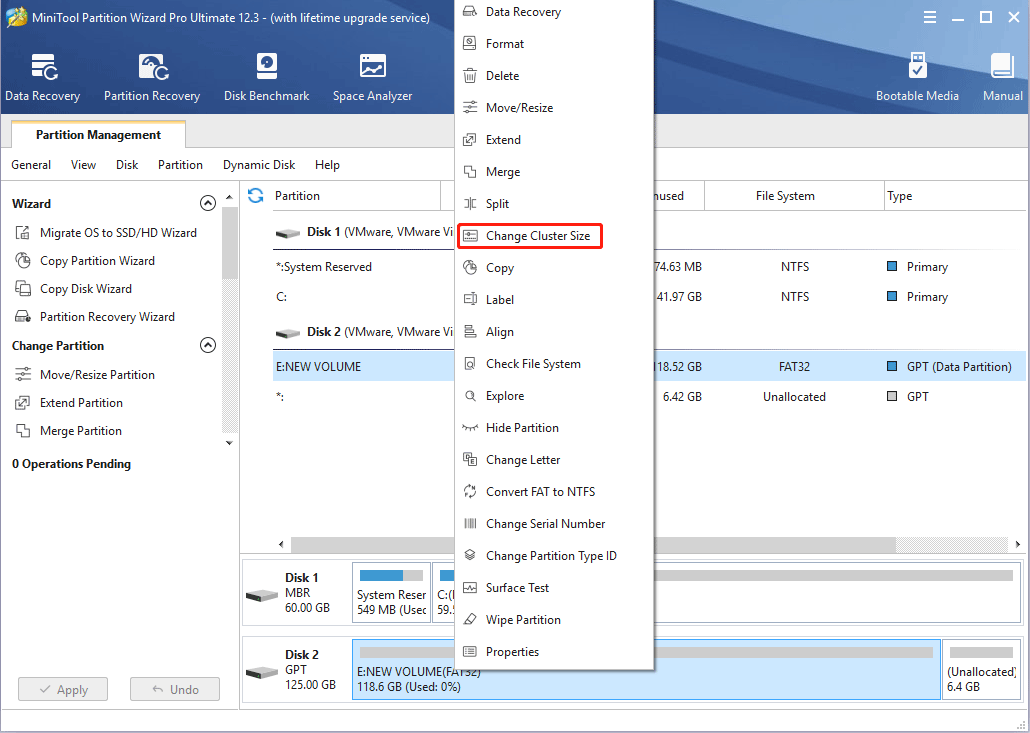
Step 4: In the pop-up window, expand the drop-down menu and choose a proper cluster size. Then, click the Yes button. Please note that a cluster is composed of one or more sectors. In this window, the value you choose is the number of sectors. The cluster size should be the number of clusters * sector size (the sector size is usually 512 bytes).
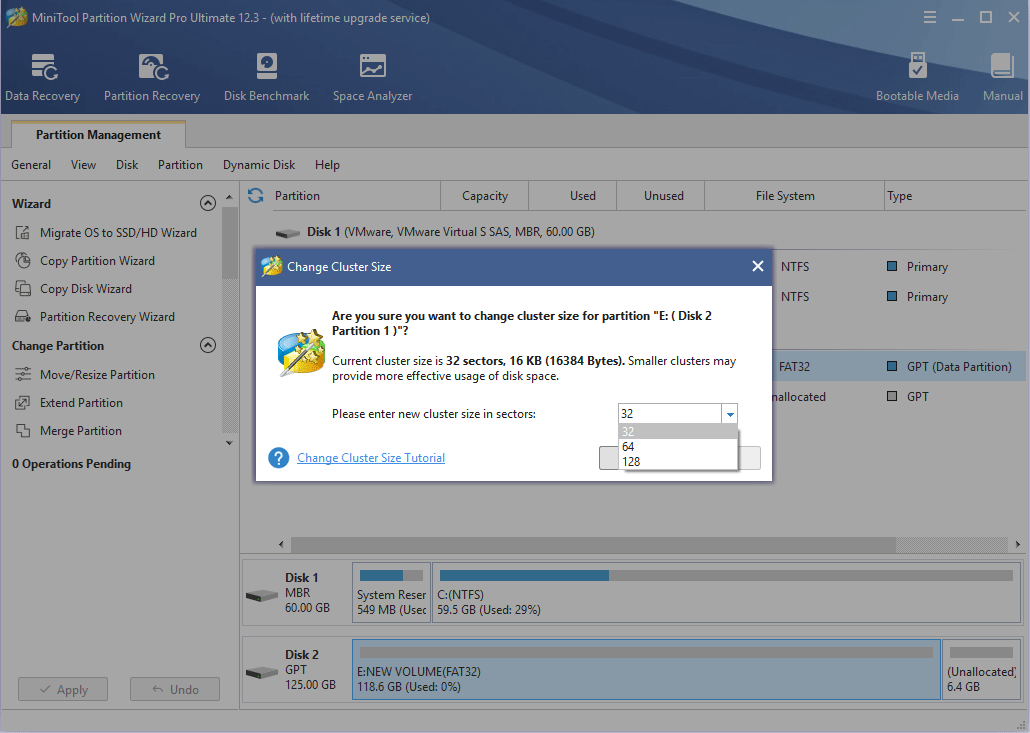
Step 5: Click the Apply button to execute pending operations.
Here is a post talking about how to work around the “FAT32 not an option” issue. If you can’t format a drive to FAT32 file system just because the PC doesn’t offer the FAT32 option, this post can help and it will tell you why this issue happens.Click to tweet
Bottom Line
Is this post helpful to you? Do you know other reasons that cause the “FAT32 not an option” issue? Do you have other ideas about cluster and cluster size? Please leave a comment in the following zone.
In addition, if you have difficulty in formatting partition, extending partition, or changing cluster size, please contact us via [email protected]. We will get back to you as soon as possible.
FAT32 Not an Option FAQ
How do I format my USB to FAT32 without the option?
Actually, if the Windows doesn’t display the FAT32 option, it means that the USB is larger than 32 GB. In this case, you can’t format USB to FAT32 via any Windows built-in utility (like File Explorer, Disk Management, and DiskPart). Instead, you need to use third-party software.
How do I force FAT32 to format?
- To force FAT32 to format, please refer to the following steps:
- Press Windows key + R key.
- In the Run box, type “cmd” and press Enter.
- In the cmd window, type “diskpart” and press Enter. The diskpart tool will be opened.
- Enter “list disk” and press Enter.
- Enter “select disk #“, where # is the number of your selected disk. Then, press Enter.
- Enter “list partition” and press Enter.
- Enter “select partition *” and press Enter.
- Enter “format fs=fat32” and press Enter.
Can I use exFAT instead of FAT32?
In general, exFAT is regarded as an alternative file system to replace FAT32. But this file system supports files larger than 4 GB and volumes larger than 32 GB. At the same time, it has greater compatibility than NTFS on more devices and operating systems. But if you really want to use exFAT to replace, please first check whether the device or system supports it.
Why I can’t format my external hard drive to FAT32?
If you can’t format external drive to FAT32, possible reasons are as follows:
- The partition that you need to format is larger than 32GB. It will show “The volume size is too big” error.
- The partition need formatting to FAT32 is not the first primary partition on removable disk. It will show “An unexpected error has occurred” error.
- The drive is write-protected. It will show “The disk is write protected” error.


